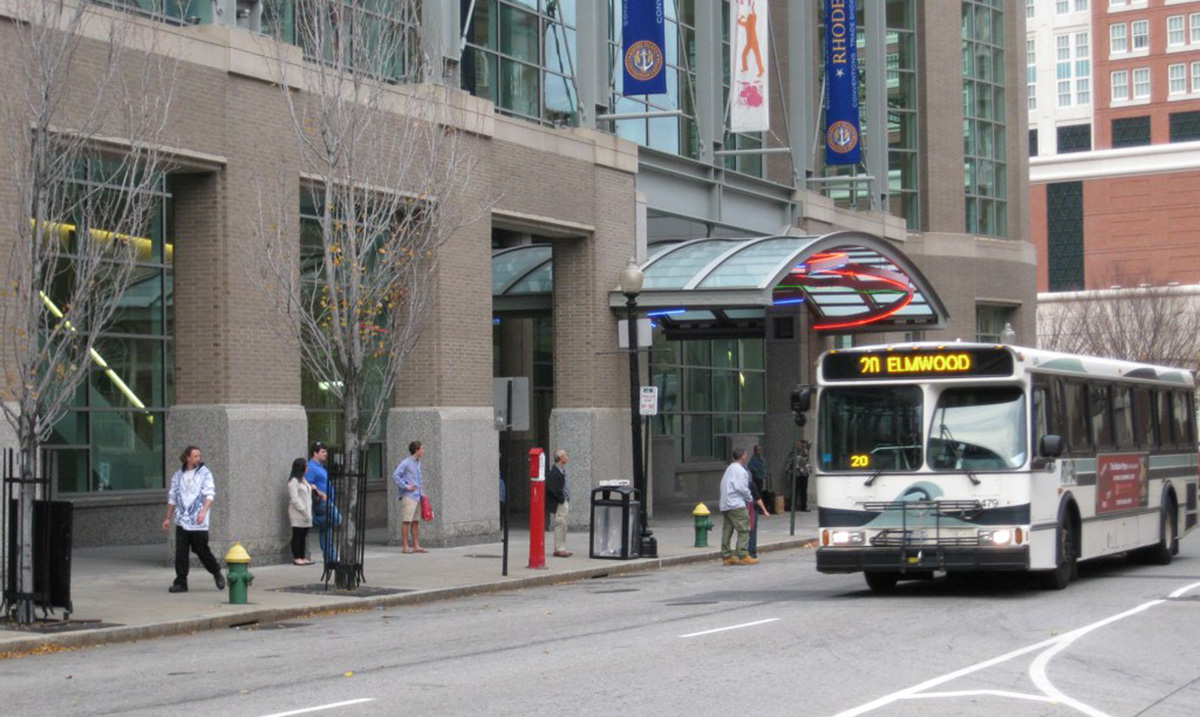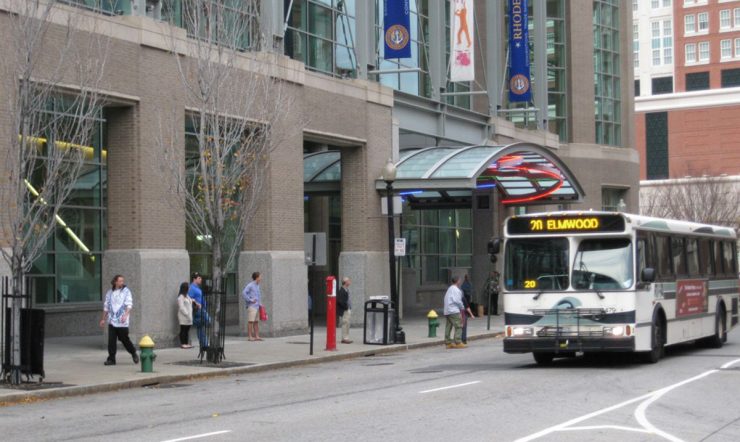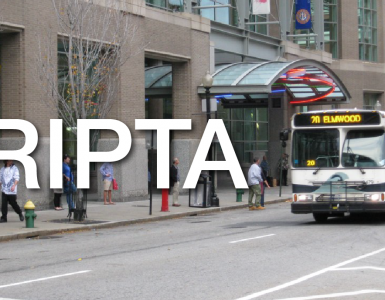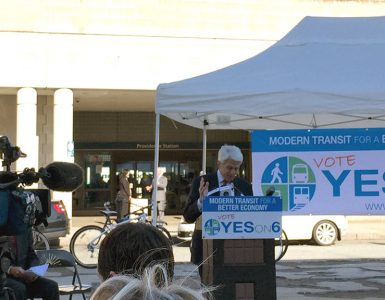
News from PBN and EcoRI about RIPTA’s proposed fare changes:
Providence Business News: RIPTA eyes expanded service, but who will pay?
A U.S. census survey, called the American Community Survey, in 2013 reported that 2.9 percent of Rhode Islanders used public transportation at least once a week.
Largely because of its small size, Rhode Island has a density that rivals New Jersey — with 1,018 people per square mile. For comparison purposes, 10.8 percent of the New Jersey population used public transportation, while 27 percent of the state of New York did so, according to the census survey.
Rhode Island’s density is what officials at state transportation agencies point to when arguing that increased investment in public transit is a smart move.
[…]And despite Rhode Islanders’ seeming preference for their own vehicles, demographic trends favor public transportation.
In the survey, conducted in the spring, about 60 percent of respondents identified availability of buses as a priority issue.
Partly in response to the surveys, the authority is looking to establish more services similar to the R-line, a popular eight-mile route connecting Providence and Pawtucket, which offers expedited trips. The R-line has its own stops, and buses come every 10 minutes. Launched in June 2014, the R-Line accounts for 15 percent of the RIPTA ridership, with more than 2.6 million rides in the last fiscal year, according to the authority.
EcoRI News: Changes Proposed to RIPTA Bus Services
[alert type=”muted”]The Rhode Island Public Transit Authority (RIPTA) recently unveiled several proposals to update fare rates at four public meetings around the state. While the base fare — $2 a ride to travel anywhere in the state — will likely remain unchanged, other fare types, such as multi-day and monthly passes, could rise in cost. Express-route fares could increase from the base fare to between $2.50 and $4 a ride.
Perhaps most significantly, seniors and people with disabilities will likely have to start paying to ride the bus. RIPTA, until recently, was required by law to provide free bus passes to those populations, which account for about a quarter of all bus trips annually.
The proposed changes are part of a transit fare study launched by RIPTA in April. The study is designed to review current and study alternative fare rates. It comes at a time when RIPTA is attempting to increase revenue to overcome an annual budget deficit, and prior to planned fare-box upgrades on buses.






It’s great to see that RIPTA wants to increase frequency for its routes. RIPTA’s goals should be to get 5 minute Headways for the R-Line and 10 minute Headways for the rest of the system, but it would be great if all the routes had 5 minute Headways.
I’m all for increasing frequency and adding additional “rapid” lines, but it seems like they’re closing their revenue shortfall on the backs of their most vulnerable customers.
JCK, There’s only so much you can do when RIPTA has a shoestring budget. I don’t want any fare increases at all. There needs to be some sort of critical mass to push for a huge increase in RIPTA’s budget or at least an increase in the gas tax.
JCK,
According to the most recent American Community Survey by the US Census Bureau folks who can be classified as elderly are far-and-away the subsection of Rhode Islanders with the assets (forget income) to pay full fare on RIPTA. It’s a shame that policy in our state demands a teenage mother enrolled in the RI Works program to pay more for transportation access than a group that by dint of its age bracket has many more subsidies to assist it. Folks with disabilities are a completely different matter of course…
We should handle getting low income people near frequent buses with subsidies to affordable housing, and with general housing growth.
Protected bike lanes would also be a major help. It sounds like a ridiculous proposal, until you count the fact that in the Netherlands protected bike lanes are used as pathways for rascals and wheelchairs. A person living fairly far from a bus stop should still be able to get their fine on their own, if we have the right infrastructure to keep people safe (but we don’t).
I’ll note that about 30% of RIPTA’s riders qualify to ride free while those who pay in the metro area pay well above average fares to ride in order to make up a reasonable farebox recovery rate. This deters commuting by transit (we are well below average in that) as we have high fares and the buses are largely seen as just for the poor.
One thing that might be done is to rethink the 200% of poverty level that DEA set to qualify. This means for example that couple could earn as much as $31,860 (in reported income) to qualify, a household of 4 can earn $48,500. Giving away rides to so many is unsustainable.
What about outside the city? RI has several large employers (e.g. CVS, Fidelity, Hasbro) with facilities outside of Providence but taking RIPTA to get to them takes 3-4x the amount of time to get there as driving does. A commute that takes 35 minutes by car can take 2 hours between walking to the bus, transit to Kennedy Plaza, and changing to the line that goes near your workplace (if it is even near at all). If the goal is to lessen traffic and lower pollution, including more outlying areas is important. The routes could even be a little pricier, as long as it compares favorably with the cost of maintaining a car. Investing in cheaper and more widely available broadband would also allow more telecommuting, in addition to other benefits.
When buses that run on barebones schedules routinely have empty seats, free riders cost the system nothing. When the numbers of nonpaying riders necessitate additional service, well, isn’t better frequency a must if you hope to attract “choice riders?”
I doubt there is much “money on the table” from riders that do not now pay who could easily come up with a dollar. Then there are the people who will stop riding if it cost a dollar. No money there. And then there are the people who really have to be somewhere even though that dollar will be a distinct hardship.
A fine plan if you believe that the way to reduce poverty is to punish people for being poor.
Absolutely agreed Andrew. When passenger fares already make up such a small percentage of Ripta’s income it just seems like throwing the poor, old and disabled under the bus as scapegoats. We want to encourage transit riding not discourage it. This will just encourage more people in these groups to use transit less and we’ll see more and more mostly empty buses running around, then it’ll only be a matter of time before people think “Oh well look how empty these busses are, clearly we don’t need this many running!”
It’s a slippery slope down a path to worse transit for everyone.
AFAIK, RIPTA doesn’t absorb the cost of “free” riders; DHS pays for them.
The problem with so many “free” riders isn’t the cost; it’s that the buses are perceived as a social service instead of a mode of transportation (and in some cases, the buses do become rolling homeless shelters). I think RIPTA has been doing an excellent job of marketing the system, and that perception will go away as long as routes and schedules are convenient, and behavior on buses and loitering around bus hubs is controlled.
Those who understandably want to protect the free riders or who want more frequency or more service to outlying areas need to help come up with a way to pay for it. RIPTA cannot print money, the budget has to be balanced by some kind of balance between the free riders paying something, higher fares on those who already pay high fares, efforts to get more paying riders, internal efficiences, service cuts, more help from employers, and more help from the General Assembly.
I have often testified at the Assembly for transit service, believe me its not easy to get more $$ from them, and the low income advocates were never there to help when they thought their free fares were assured (until late in this session when it seemed this might change.) It would also help if instead of disparaging transit service we more often encouraged folks to give it a try, especially if going downtown where service is often better than most non-users think it is.
It is not true that DHS pays the costs of providing the free rides. While RIPTA does get about $3 million from the DHS share of a 1 cent gas tax for the elderly, at about $5/ride (roughly $100 million budget/ 20 million passengers) the cost is about $28 million, not $3 million. Perhaps a fairer comparison is that if the average fare is about $1.50 (taking into account discounts from monthly passes, Upass, Riptiks etc) the free rides should be contributing about $8.4 million in fares, but RIPTA only gets about $3 million for it.
I don’t think the spirit of demanding things for free is good for the country. In transportation we have those who want the free buses, the free use of roads and expensive new bridges without tolls, free parking at work. The net result is a limited transit system that doesn’t much help our environment or land use, deteriorated roads and bridges, and ever more garages, parking lots, even more of the State House lawn paved over. Ugh.
To update, the RIPTA Board voted to go to the public process of fare increases – the $1 all day fare on the low income seniors/disabled, but also an increase in the monthly pass from $62 to $70, weekly passes $23 to $25 and transfers from $.50 to $1.
RIPTA Riders Alliance is holding a rally to seek alternatives to fare increases on Thurs Nov 19 at the State House 4pm as well as working on a petition and political campaign. This time there is help from the seniors and low income advocates as they are no longer assured of no fare increase.
So if I’m understanding this right, seniors and the disabled who were above the income limit actually come out slightly ahead because they now can ride at half fare all hours instead of off-peak only. Also, interesting that phase 2 of the new fare structure will result on the elimination of transfers, except when the new smart card is used (included in the fare).
Towne, you have that right, but the income limits are so high to qualify for free rides that almost no seniors who do use transit much actually pay any fares. Apparently it is not worth the administrative hassle to distinguish the groups.
Another way to go would have been to reduce the incomes for eligibility to get some revenue, keep the free program from continuing to grow out of control, and still protect the very low income folks. But RIPTA does not decide the income limits, I think it is up to DHS.
I’ve also been advocating a much lower cost monthly pass, maybe $20, for the senior/disabled. RIPTA is proposing half-fare $35/month for them, but most don’t commute regularly and needing 35 trips before any savings is daunting. Also encouraging a pass would not slow down boarding so much.